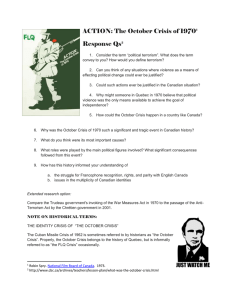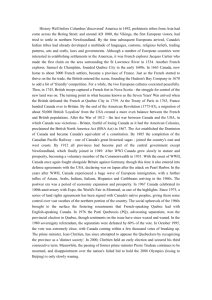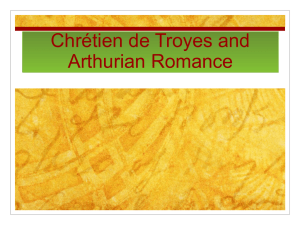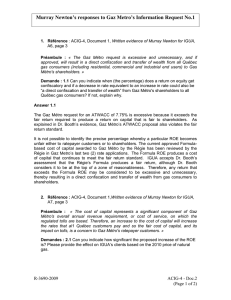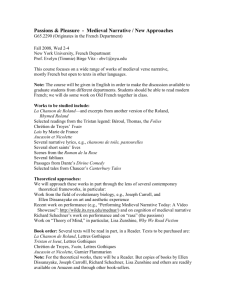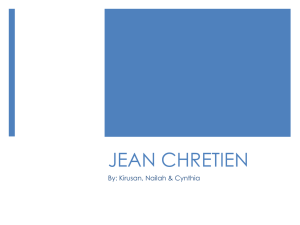Demande de modifier les tarifs de SCGM à compter du... octobre 2007 R-3630-2007 DR. BOOTH’S INFORMATION REQUESTS #1 ON DR. CHRÉTIEN’S EVIDENCE
advertisement
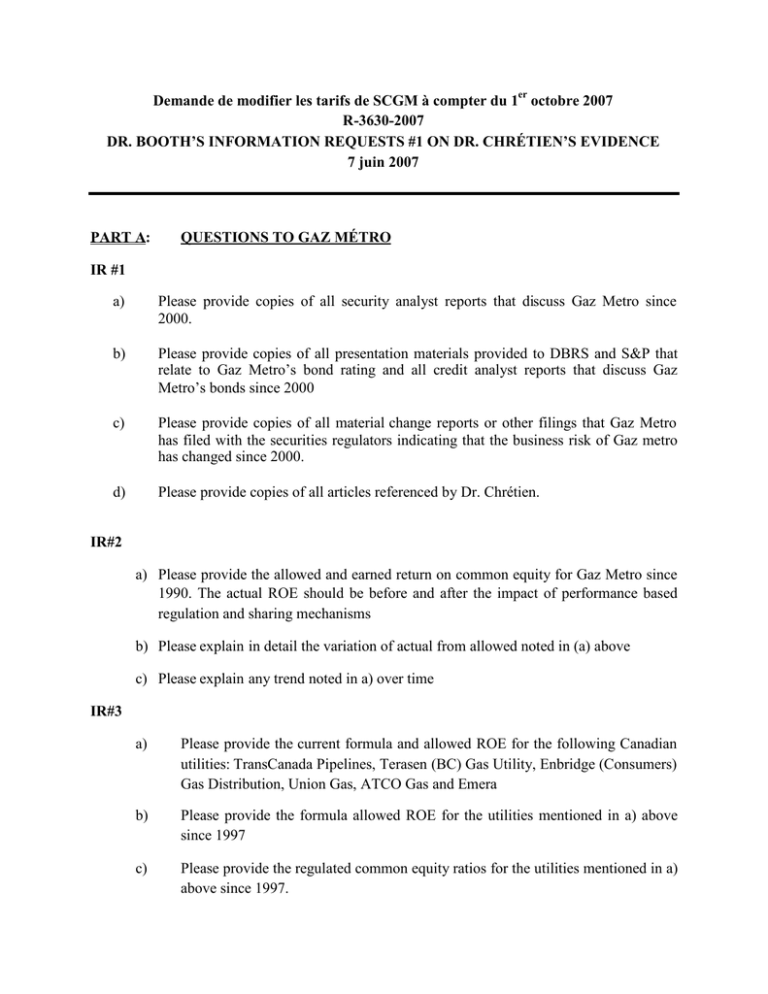
Demande de modifier les tarifs de SCGM à compter du 1er octobre 2007 R-3630-2007 DR. BOOTH’S INFORMATION REQUESTS #1 ON DR. CHRÉTIEN’S EVIDENCE 7 juin 2007 PART A: QUESTIONS TO GAZ MÉTRO IR #1 a) Please provide copies of all security analyst reports that discuss Gaz Metro since 2000. b) Please provide copies of all presentation materials provided to DBRS and S&P that relate to Gaz Metro’s bond rating and all credit analyst reports that discuss Gaz Metro’s bonds since 2000 c) Please provide copies of all material change reports or other filings that Gaz Metro has filed with the securities regulators indicating that the business risk of Gaz metro has changed since 2000. d) Please provide copies of all articles referenced by Dr. Chrétien. IR#2 a) Please provide the allowed and earned return on common equity for Gaz Metro since 1990. The actual ROE should be before and after the impact of performance based regulation and sharing mechanisms b) Please explain in detail the variation of actual from allowed noted in (a) above c) Please explain any trend noted in a) over time IR#3 a) Please provide the current formula and allowed ROE for the following Canadian utilities: TransCanada Pipelines, Terasen (BC) Gas Utility, Enbridge (Consumers) Gas Distribution, Union Gas, ATCO Gas and Emera b) Please provide the formula allowed ROE for the utilities mentioned in a) above since 1997 c) Please provide the regulated common equity ratios for the utilities mentioned in a) above since 1997. Dr. Booth’s Information Requests #1 on Dr. Chrétien’s Evidence R-3630-2007 Page 2 IR#4 PART B: a) Please discuss in detail all deferral accounts available to Gaz Metro, summarize their operation and list their balances for each year since 1997. b) Please list the distribution revenue requirement for each year since 1997 and express the deferral account balances as a percentage of this amount for each year. QUESTIONS TO DR. CHRÉTIEN IR#5 Preamble: Dr. Chrétien’s testimony page 5 With reference to Dr. Chrétien’s statement that the first step is to ensure that the formula generates an average rate of return earned by firms or portfolios of firms comparable to Gaz Métro a) Please indicate and provide all analyses undertaken by Dr. Chrétien to justify the assumption that Gaz Metro is equivalent in risk to the sample of firms he uses as proxies, b) Please confirm that he is using a sample of utility holding companies (UHC’s) as proxy for Gaz Metro and has made no adjustments for the lower risk of pure regulated utilities relative to the UHCs. c) Please confirm that if the allowed ROE is less than the investor’s required rate of return, the market value of a regulated utility’s operations would be below book value, if not why not. d) Please indicate any sales of utility operations in Canada that have been made at less than book value since 1997. IR#6 With respect to Dr. Chrétien’s comments on the CAPM on page 6 a) Please confirm that an assumption in the tests of the CAPM is that on average realized returns equal expected returns. b) In Dr. Chrétien’s judgment, since 1989, have realized returns on long Canada bonds equaled expected returns? Please provide any quantitative evidence to support your answer. Dr. Booth’s Information Requests #1 on Dr. Chrétien’s Evidence R-3630-2007 Page 3 c) Given the answer to b) above, does Dr. Chrétien believe that a) has held for dividend/interest sensitive stocks like utilities and income trusts? IR#7 With respect to Dr. Chrétien’s comments on the Fama French model on page 7 a) Please provide copies of Dr. Chrétien’s course outlines for academic year 2006/7 highlighting where he discussed modern portfolio theory and the CAPM and the Fama French model, b) Please indicate how many hours in Dr. Chrétien’s course were devoted to portfolio theory and the CAPM and how many on the Fama French model, c) Please provide extracts from the decision of any Canadian regulatory bodies that have explicitly placed any weight on the Fama French model. IR#8 With respect to Dr. Chrétien’s conclusion that 10.19% is a fair ROE for Gaz Metro on page 9 a) Please indicate the realized excess return of Canadian equities over long term bonds since the creation of the TSE index data in 1956. b) Please indicate what the forecast market equity return would be if the historic market risk premium calculated in a) is added to the current forecast long Canada bond yield of 4.30% . c) In Dr. Chrétien’s judgment is a return for Gaz Metro of 10.19% fair relative to the market return estimated in b)? d) Please indicate the allowed ROE for Canadian and US utilities the last time that long government bond yields were at the 4.3% level. e) In Dr. Chrétien’s judgment, were utilities more or less risky at the time of the answer to d) above than today. Please be specific and provide details. IR#9 With respect to Dr. Chrétien’s comments on estimating the fair ROE on page 12 a) Please provide all the analysis undertaken to justify the use of a one month holding period for estimating the fair ROE for utilities, Dr. Booth’s Information Requests #1 on Dr. Chrétien’s Evidence R-3630-2007 Page 4 b) Please provide all analyses undertaken to ensure that the use of utility holding companies (UHCs) are a useful proxy for Gaz Metro. c) Please provide all justification for relying on statistical tests using treasury bills as the risk free rate and raw or unadjusted betas as the risk measure, when in utility applications of the CAPM betas are “adjusted” and a long Canada bond yield is used as the risk free rate, d) Please indicate all regulatory decisions where the CAPM has been used using a treasury bill yield as he risk free rate and raw or unadjusted betas were used as the risk coefficient. IR#10 With respect to Dr. Chrétien’s risk positioning of Gaz Metro discussed on pages 14-15 a) Please indicate the proportion of total revenues generated from the local distribution of natural gas for each company in the five samples, b) Please indicate and provide any Canadian decision by a regulator that has explicitly accepted a US sample of regulated firms as a suitable proxy for setting the allowed ROE or capital structure for a Canadian gas LDC. c) Please indicate why Dr. Chrétien would include income funds as a proxy for Gaz Métro. d) Please include the monthly “cash on cash” or running yield for Energy Savings Income Fund and Pembina Income Fund as well as for Gaz Métro since January 1992. e) Please provide the beta estimates for each of the individual firms used in the five samples, since the start of each sample period based on five year estimation windows updated each month. That is, for example for the USindex starting in February 1973, estimate the betas for the five year period to January 1978 and then update the estimates by adding February 1978 and dropping February 1973. Dr. Booth’s Information Requests #1 on Dr. Chrétien’s Evidence R-3630-2007 Page 5 IR#11 With respect to the Régie’s decision referenced by Dr. Chrétien on page 16 a) Please indicate any decision by a Canadian regulator other than the Régie that has placed any weight on US market risk premium evidence, b) Please indicate what proportion of Canadian portfolio outflows in each year since 2000 that went to the US and the breakdown in terms of equity versus debt instruments. IR#12 With respect to Dr. Chrétien’s use of correlation coefficients on page 17 a) Please provide all justification for using correlation coefficients to indicate that securities or portfolios are close substitutes. b) Please indicate what would happen to the correlation coefficient if the US stocks were regarded as riskier and consistently earned 2% more than the Canadian securities. c) Please confirm that if financial markets were completely segmented but the real markets are integrated, then it is perfectly possible for returns on two securities to be positively correlated but one security to earn consistently more than the other. If not please explain why not. IR#13 With respect to Dr. Chrétien comments on the risk free rate on page 21, a) Please provide all references to any of Canadian regulator decisions that have implemented a formula adjustment mechanism to the effect that the adjustment formula implements a “modified risk free rate.” b) Please provide extracts from the BC Utilities Commission (BCUC) and National Energy Board (NEB) decisions in 1995 that indicate the direction given to parties to submit evidence on the introduction of an ROE adjustment mechanism. Please highlight any areas where those decisions discuss the adjustment mechanisms as “modified risk free rates” Dr. Booth’s Information Requests #1 on Dr. Chrétien’s Evidence R-3630-2007 Page 6 c) Please confirm that both the BCUC and NEB intended the adjustment mechanisms to be a process of automatically adjusting the utility risk premium and not the risk free rate. IR#14 With respect to Dr. Chrétien comments on the risk free rate on page 24. a) b) c) Dr. Chrétien states that the use of an adjustment mechanism for the allowed ROE is a form of Vasicek mean reverting model and that the 30 year expected rate of return plays the role of an average towards which the long term rate “converges.” If the current rate stays at 4.3% indefinitely please explain how this model assumes that the “modified” rate converges to the 1999 rate. Please confirm that when the 75% adjustment was incorporated it was based on the Régie’s estimate of a fair ROE for Gaz Métro and that if the long Canada bond yield at that time had been 4.84%, 6.41% or 6.10% (page 25) the Régie’s estimate of the fair ROE would have been different. Please estimate the risk premium for Gaz Metro for 1999 assuming that the fair ROE for Gaz Metro was the allowed ROE determined by the Régie at that time (Decision 99-11) and also estimate the returns for 2007 and 2008 that results in the application of the formula to that risk free rate and risk premium. IR#15 With respect to Dr. Chrétien comments on tests of the CAPM discussed on pages 26-30, a) Please discuss the Roll critique of these asset pricing tests, b) Please indicate whether these tests used a short term (usually treasury bill) yield as the risk free rate, Please indicate which of these tests used a long term government bond yield as the risk free rate, c) i. Please indicate whether in Dr. Chrétien’s judgment the long term (30 year) government bond yield normally exceeds the short term Treasury bill yield and estimate this difference using Canadian government securities using monthly data from 1956. ii. Please confirm that if the long Canada bond yield exceeds the Treasury bill yield by 1.25% on average this will cause a higher intercept for the empirical or ex post security market line (CAPM), Dr. Booth’s Information Requests #1 on Dr. Chrétien’s Evidence R-3630-2007 Page 7 iii. Please confirm that the historic average market risk premium estimated with long Canada bonds as the risk free rate is smaller than that estimated using treasury bill yields as the risk free rate, due to this term premium, iv. Please confirm that the use of a long Canada bond yield as the risk free rate increases the intercept and lowers the slope of the security market line (CAPM) consistent with the classic results of Black Jensen and Scholes and others that he refers to, v. Please confirm that regulatory decisions in Canada as well as the adjustment model used by the Régie uses long Canada bond yields as the risk free rate. Please reference any decision of a Canadian regulator that has used a short term Treasury bill yield to set the allowed ROE for a utility. d) Please confirm that tests of asset pricing models use actual betas over the previous time period (usually 60 months) and not adjusted betas. If Dr. Chrétien cannot confirm this please provide references to tests of the CAPM or other asset pricing models where other beta estimates have been used, i. Please provide estimated beta coefficients for Gaz Métro starting in 1990 based on sixty months of holding period data with the beta re-estimated each month to include the additional one month’s holding period return, ii. Please discuss the stability of these estimated betas and whether in Dr. Chrétien’s judgment each estimate represented the “best” beta estimator at that point in time, iii. Please confirm that testing the CAPM in the manner of Black Jensen and Scholes is equivalent to using these “raw” or estimated betas without any adjustment, e) Can Dr. Chrétien please provide any references to tests of the CAPM where it is estimated using the procedures used in Canadian regulatory decisions with long Canada bond yields as the risk free rate and adjusted or long run betas. IR#16 With respect to Dr. Chrétien discussion of the Fama French model on page 34, a) Please explain in detail why size and market to book ratios are risk factors, b) Please reference any general (or partial) equilibrium model that results in size or the market to book ratio being a risk factor affecting required rates of return, Dr. Booth’s Information Requests #1 on Dr. Chrétien’s Evidence R-3630-2007 Page 8 c) Please confirm that other factors have also been documented in the literature such as momentum, liquidity, and skewness, d) Please explain what Dr. Chrétien understands by data mining, e) Please explain what diversification means and why holding the market portfolio is optimal under the assumptions of the CAPM, f) Please explain Sharpe’s “multi-beta” model and why even if investors hold a diversified portfolio and the CAPM holds other factors can empirically drive asset prices. IR#17 With respect to Dr. Chrétien comments on the Fama French model on page 35, a) Please provide copies of the two Fama French tests on Canadian securities referenced there, b) Please explain in detail why size and market to book might be seen as hedges against changes in the opportunity set as discussed by Merton (1973) on page 35, c) Please confirm that the use of the CAPM in regulatory hearings over the last twenty years has used changes in the market risk premium and beta estimates in the manner discussed by Jaganathan and Wang as a conditional CAPM (CCAPM). If not please explain why not and reference any Canadian regulatory decisions that have used the same estimate of the market risk premium over the last twenty years, IR#18 With respect to Dr. Chrétien comments on estimating the Fama French model on page 38, a) Please confirm that the Fama French factors are security returns based on portfolios of securities that differ in size and their market to book ratio, so that the factors are security returns similar to the return on the market portfolio. If Dr. Chrétien cannot confirm please provide his understanding of what these factors are. b) Please indicate whether he has used the Fama French factors from Ken French’s web page: Dr. Booth’s Information Requests #1 on Dr. Chrétien’s Evidence R-3630-2007 Page 9 i. If the answer is yes, please confirm that these security returns are from the US capital market and reflect a period when Canadian investors faced institutional and tax restrictions in investing in the US, ii. If the answer is no, please discuss the source of the Fama French Canadian factors and provide all data used to estimate the Fama French factors and the computer programs that derived them from the underlying data in a format that enables replication, c) Please confirm that the tests referred to in this section are simply tests of the ability of a model to predict the actual realized security returns over the estimation period, that is they are curve fitting exercises, d) Further to c) please confirm that for these to be estimates of expected rates of return the realized return has to be on average equal to the expected rate of return, if not why not. e) Please provide all statistical analysis that Dr. Chrétien has performed to justify the assumption that average returns over his estimation period equaled expected returns for the securities examined, the reference portfolios and the value and growth portfolios. f) Please provide copies of any published research by Professor Fama that estimates the market risk premium and explain why Dr. Chrétien has not referenced this research when he has used Fama’s research extensively elsewhere, IR#19 With respect to Dr. Chrétien comments on beta adjustments on page 45, a) Please confirm that the Blume study was for the overall capital market and the reason that betas converge towards 1.0 is that the average beta for the market as whole is 1.0. That is, randomly observing a beta of say 0.20, when all else constant, the prior is that the beta is 1.0 leads to an adjustment towards 1.0. b) Please provide all research that Dr. Chrétien is aware of on the time series properties of beta estimates for utility holding companies (UHCs) Dr. Booth’s Information Requests #1 on Dr. Chrétien’s Evidence R-3630-2007 Page 10 c) Is it Dr. Chrétien’s view that UHC beta estimates converge towards 1.0 and that they are of average risk? If so please provide all statistical support and references to the literature that indicate that beta estimates of Canadian UHCs converge towards 1.0 IR#20 With respect to Dr. Chrétien’s estimates of the market risk premium on page 50 a) Please provide the underlying data from which these risk premiums were derived both in raw form and as annual rates of return in excel files, b) Please explain in full why the time period starts in 1950 when the TSE indexes only go back to 1956. Please estimate the market risk premium starting in 1956 using standard TSE data. c) Please explain why the value premium starts in 1977 and discuss any biases this may create given that the great bull market started in 1981 with the drop in government bond yields. Estimate the return on holding the long government bond over this same time period from 1977 and contrast with the value premium results. d) Please explain in detail why US size and value premiums going back to 1927 are of any relevance to Canadian expected rates of return given that the markets were effectively segmented for most of that time period. If Dr. Chrétien believes that the Canadian and US markets have always been integrated please provide any statistical support or references to the literature that support that assertion and explain why returns in the US have been on average at least 2.0% higher than in Canada. IR#21 With respect to Dr. Chrétien beta estimates on page 52, a) Please confirm that Dr. Chrétien’s Canadian sample has lower betas than his US sample both in terms of market and value and size betas, b) Please confirm that Dr. Chrétien’s estimates in Table 5 indicate that Canadian UHCs are lower risk than US UHC’s, if not why not, c) Given Dr. Chrétien’s beta estimates in Table 5 and his risk premium estimates, how much lower does he estimate the fair ROE for Canadian versus US UHC’s to be? Dr. Booth’s Information Requests #1 on Dr. Chrétien’s Evidence R-3630-2007 Page 11 d) Given the lower risk measures for Canadian UHC’s than US IHCs why does Dr. Chrétien use US UHC’s as a proxy for Gaz Métro? IR#22 With respect to Dr. Chrétien’s risk premium estimates on page 54, a) Please confirm that Dr. Chrétien’s best estimates of the risk premium for his proxies for Gaz Métro are 5.568%, 6.183%, 6.102% and 6.242%, b) Please confirm that his best estimate of the Canadian market risk premium as a whole (Table 4) is 5.565%, c) Please confirm that Dr. Chrétien’s “conservative” estimate for Gaz Metro’s risk premium places it as equivalent in risk to investing in the Canadian market as a whole, that is 5.568% is essentially the same as 5.565%. d) Please confirm that Dr. Chrétien is seriously recommending to the Régie that Gaz Métro is an average TSE listed stock and equivalent in risk to a typical Canadian equity security. IR#23 With respect to Dr. Chrétien risk positioning for Gaz Métro on page 56, a) Please indicate all work that Dr. Chrétien has undertaken to validate Dr. Carpenter’s judgment of the three factors listed on page 56, that is, how much of Dr. Chrétien’s recommendations are based on Dr. Carpenter’s judgment of Gaz Métro rather than his own? b) With respect to a), can Dr. Chrétien indicate how many times he has testified or provided evidence on risk positioning for regulated Canadian utilities. c) Please reconcile Dr. Chrétien’s reduction of Gaz Métro's risk premium by 0.50% for performance based regulation, when Dr. Carpenter cites this as a major risk factor warranting a higher risk premium. Dr. Booth’s Information Requests #1 on Dr. Chrétien’s Evidence R-3630-2007 Page 12 IR#24 With reference to integrated capital markets on page 59 a) As capital markets open up and there are increased diversification opportunities to reduce risk, what in Dr. Chrétien’s judgment happens to risk premiums? b) Please provide references to any literature that indicates that risk premiums increase when capital markets are opened up, please be specific in citing any reasons that Dr. Chrétien might offer for higher risk premiums. c) Please provide the non-Canadian ownership of Gaz Métro on a yearly basis since 1992 d) Please provide a full discussion of any and all legal and tax impediments to foreign (particularly US) investors buying Gaz Metro’s partnership units, e) Please provide a table showing the non-Canadian ownership of Canadian regulated utility assets and whether this has increased or decreased since 1997. f) Please confirm that Dr. Chrétien’s risk measures place US LDCs as riskier than Canadian ones, so that they should have higher allowed ROEs than Canadian LDCs, if not why not. IR#25 With respect to Dr. Chrétien’s fair ROE recommendation for 2008 on page 62, a) Please confirm that he believes that the allowed ROE’s resulting from the adjustment formulae in use by the BCUC, Alberta EUB, Manitoba PUB, the OEB, the NEB and currently the Régie provide unfair allowed ROEs, b) Please confirm that if allowed ROEs are unfair, dissatisfied investors will sell the securities and allocate their capital elsewhere, thereby depressing the prices of regulated assets and causing the capital attraction standard to fail, c) Please provide data and supporting references to any Canadian utility holding companies where Dr. Booth’s Information Requests #1 on Dr. Chrétien’s Evidence R-3630-2007 Page 13 i. ii. iii. iv. share issues have netted below book value since 1994, bond issues have occurred at non-investment grade bond ratings, sales of regulated utility assets have occurred below book value. anything that indicates that Canadian utilities on ROE adjustment mechanisms cannot attract capital on fair and reasonable terms. IR#26 With respect to Dr. Chrétien’s fair ROE recommendation of 10.19% a) please contrast current capital market conditions with those in 1999 and 2003 when the Régie introduced and reviewed its ROE adjustment mechanism based on i. ii. iii. iv. v. vi. vii. viii. ix. b) GDP growth rate CPI inflation rate Bond yield spreads The state of equity markets (TSE/TSX index values) New Issue activity Real yields (Canada inflation indexed bond) Long Canada bond yields Indicators of capacity constraints The value of the C$ In Dr. Chrétien’s judgment are economic conditions at the current point in time better or worse than in the two previous time periods making it easier or harder for a regulated utility to raise capital? Please discuss in detail. *****
